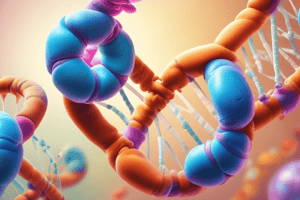Podcast
Questions and Answers
What is a key characteristic that distinguishes eukaryotic cells from prokaryotic cells?
What is a key characteristic that distinguishes eukaryotic cells from prokaryotic cells?
Which of the following organisms falls under the prokaryotic category?
Which of the following organisms falls under the prokaryotic category?
Which statement best describes the relationship between structure and function in cells?
Which statement best describes the relationship between structure and function in cells?
What similarity is shared among all cells regardless of their type?
What similarity is shared among all cells regardless of their type?
Signup and view all the answers
Which process allows cells to divide and is fundamental for reproduction and growth?
Which process allows cells to divide and is fundamental for reproduction and growth?
Signup and view all the answers
What role do chloroplasts play in plant cells related to energy?
What role do chloroplasts play in plant cells related to energy?
Signup and view all the answers
What is the primary energy source entering an ecosystem?
What is the primary energy source entering an ecosystem?
Signup and view all the answers
In which form is energy primarily lost from an ecosystem after being utilized?
In which form is energy primarily lost from an ecosystem after being utilized?
Signup and view all the answers
What best describes the functions of prokaryotic cells compared to eukaryotic cells?
What best describes the functions of prokaryotic cells compared to eukaryotic cells?
Signup and view all the answers
Which feature is exclusive to eukaryotic organisms compared to prokaryotic organisms?
Which feature is exclusive to eukaryotic organisms compared to prokaryotic organisms?
Signup and view all the answers
Study Notes
The Continuity of Life
- Heritable information is encoded in DNA, foundational to life's continuity.
- Chromosomes house most of a cell's genetic material as DNA.
- Genes are the inheritance units, transferring information from parents to offspring.
DNA Structure and Function
- Each chromosome consists of a long DNA molecule containing hundreds to thousands of genes.
- DNA is inherited from parents, influencing organism development and maintenance.
- DNA’s double helix structure comprises two long chains made of nucleotides.
- Genes indirectly regulate protein production: DNA is transcribed to RNA and then translated to protein, known as the central dogma.
- The genome encompasses an organism's complete genetic instructions.
Advances in Systems Biology
- High-throughput technology generates substantial data, enhancing biological research.
- Bioinformatics involves computational tools for processing large data volumes.
- Collaboration among interdisciplinary research teams is vital for breakthroughs in this field.
Feedback Mechanisms
- Negative Feedback: Process slows production as more product accumulates.
- Positive Feedback: Process speeds up to produce more as product accumulates.
Evolution
- Evolution explains the unity and diversity of life, as emphasized by Theodosius Dobzhansky.
- Approximately 1.8 million species have been identified; total estimates range from 10 million to over 100 million species.
Classifying Life
- Taxonomy classifies living beings into hierarchical groups, emphasizing the three-domain system.
- Domains Bacteria and Archaea include prokaryotes, while Domain Eukarya encompasses all eukaryotic organisms.
Unity in Diversity
- All organisms share DNA as a universal genetic language.
- Common structural features, such as cilia architecture, illustrate unity across diverse life forms.
Charles Darwin and Natural Selection
- Darwin’s 1859 work outlined two key tenets: species undergo "descent with modification" and natural selection as a mechanism for evolution.
Properties of Life and Biological Inquiry
- Life is defined by actions and adaptations through inheritance.
- Biology explores various fundamental questions regarding organisms' development and interactions.
Emergent Properties
- Emergent properties arise when components within a system interact, demonstrating characteristics not evident in individual parts (e.g., a disassembled bike).
Ecosystem Dynamics
- Ecosystems function through two primary processes: nutrient cycling and energy flow, with energy entering from sunlight and leaving as heat.
Energy Conversion
- Work necessitates energy, stored in forms such as light, chemical, kinetic, or thermal.
- Energy transformations are crucial for ecological processes.
Structure and Function Correlation
- Structure and function are interconnected; for example, a leaf's flat shape optimizes light capture for photosynthesis.
Cellular Organization
- Cells are the fundamental units of life, enclosed by membranes, utilizing DNA for genetic information.
- Cell division is essential for reproduction, growth, and the healing of multicellular organisms.
Eukaryotic vs. Prokaryotic Cells
- Eukaryotic cells contain membrane-bound organelles, with the nucleus as the largest.
- Prokaryotic cells, such as bacteria and archaea, lack a nucleus and membrane-bound organelles, making them simpler and generally smaller.
Studying That Suits You
Use AI to generate personalized quizzes and flashcards to suit your learning preferences.
Related Documents
Description
This quiz explores the continuity of life through the lens of DNA structure and function. It addresses the role of chromosomes, genes, and how genetic information is passed from parents to offspring. Test your understanding of the molecular foundations that underlie inheritance and biological development.




